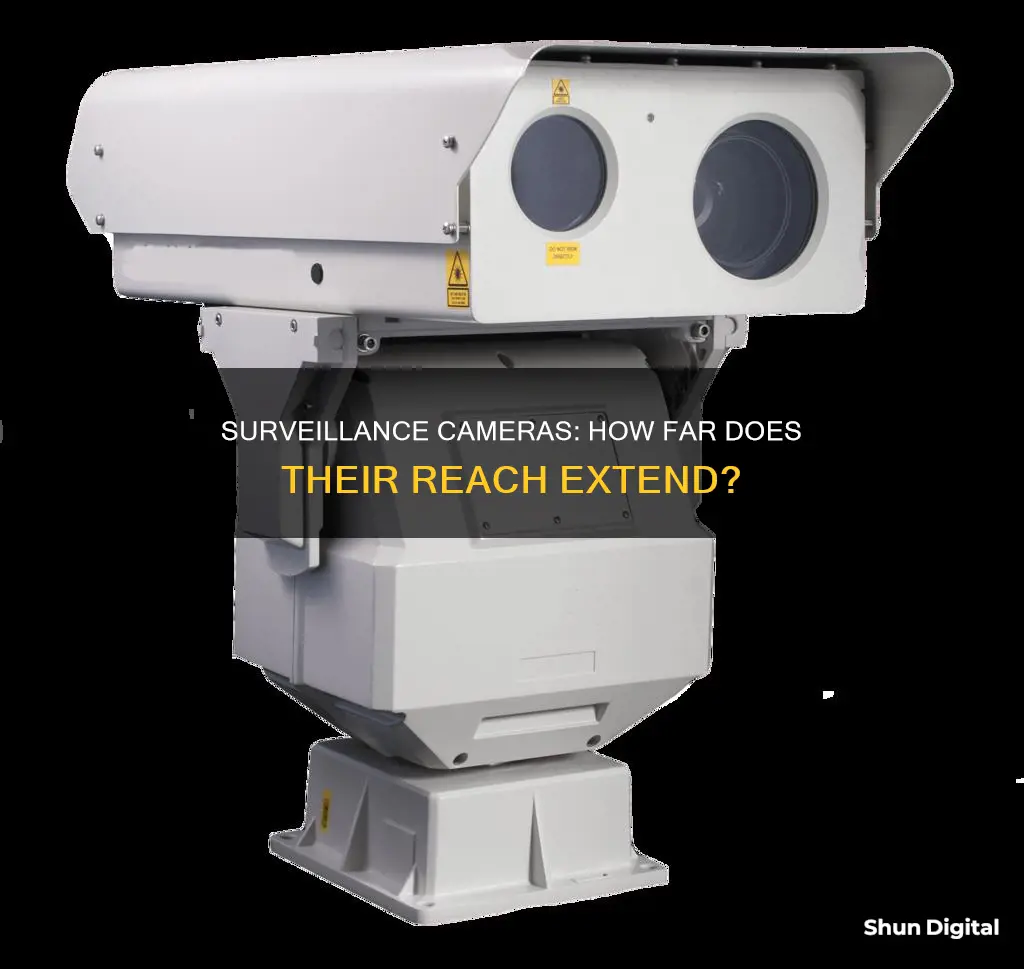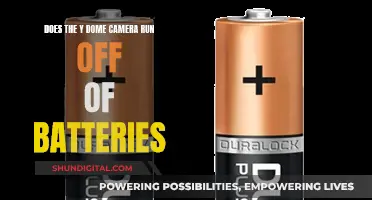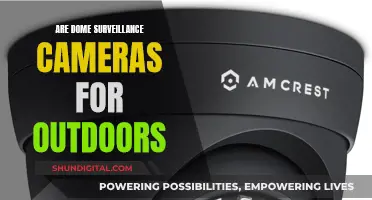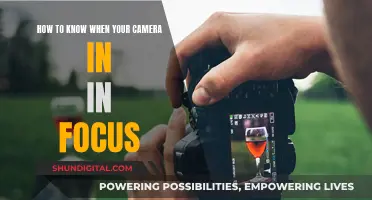
The range of a surveillance camera depends on several factors, including lens focal length, location, and resolution. A standard security camera typically has a viewing range of 30 to 100 feet, but this can be extended with certain types of cameras, such as PTZ cameras, which can capture images and video at distances of over 100 feet, with some models reaching up to 200 feet or more. The focal length, or size of the camera lens, is the primary factor influencing how far a surveillance camera can see. A smaller focal length provides a wider field of view, while a larger focal length allows for a narrower, more focused view over a greater distance.
| Characteristics | Values |
|---|---|
| Viewing range | 30 to 100 feet (9-30m) |
| Focal length | Distance between lens and sensor; longer focal length = narrower field of view but sees further |
| Camera resolution | Higher resolutions see further; common resolutions include 720p, 1080p, 4MP, 5MP, and 8MP/4K |
| Night vision capability | Infrared, thermal, and low-light night vision technologies |
| Camera location | Adjust placement and angle to avoid obstructions and capture wider field of view |
| Camera quality | Higher-quality cameras have better lenses and image sensors, capturing clearer and more detailed images at longer distances |
What You'll Learn

What factors influence a camera's range?
The range of a camera's view depends on several factors. Firstly, the focal length of the lens plays a significant role. A smaller focal length provides a wider field of view, while a larger focal length results in a narrower field. For instance, a 4.0 fixed-lens camera is sufficient to capture details within 40 feet. On the other hand, PTZ or zoom cameras are more suitable for viewing areas beyond this distance.
The resolution of the camera is another critical factor. Higher resolutions, such as 4MP, 5MP, or 4K, can capture vivid details at a greater distance. The location of the camera also matters; obstructions like walls, floors, or trees can weaken the signal strength and impact the range.
Additionally, the quality of the camera itself is a factor. Reputable brands with a large customer base often offer better performance and technical support compared to lesser-known sellers. When it comes to night-time viewing, the number and type of LEDs, lux rating, 3D-DNR function, and infrared technology become influential factors in determining the range of a camera's visibility.
The security industry uses the term "Pixels Per Foot" (PPF) to measure the size of an object on a recorded video. PPF depends on the distance from the camera, the focal length, and the resolution. The higher the PPF, the better the quality of the video and the ability to identify individuals or objects.
Hubble's Camera: Unmatched Resolution in Space Exploration
You may want to see also

What is the range of a regular security camera?
The range of a regular security camera varies depending on several factors, including the type of camera, lens, resolution, location, and environment.
Camera Type
PTZ cameras, for example, can capture images and videos beyond 100 feet, while a typical security camera has a viewing range of about 30 to 100 feet.
Lens
The focal length of the lens plays a crucial role in determining the range of a security camera. A longer focal length allows the camera to see further but results in a narrower field of view. Conversely, a shorter focal length provides a wider field of view but reduces the viewing distance.
Resolution
The resolution of the camera also impacts its range. Higher resolutions, such as 4K or 8MP, enable cameras to see further and capture more detailed images.
Location and Environment
The placement and angle of the camera can affect its range. Obstructions like walls, trees, or other objects can block the camera's view and reduce its effective range. Additionally, wireless security cameras may experience interference from other wireless devices, affecting their performance and range.
In summary, the range of a regular security camera can vary significantly depending on the specific camera specifications, installation, and environmental factors. By considering factors such as camera type, lens focal length, resolution, and optimal placement, you can maximise the range and effectiveness of your security camera system.
Charging the Noorio Camera: A Quick Guide
You may want to see also

How does lens size affect a camera's range?
The lens size of a camera has a direct impact on the image quality and range. The diameter of a camera lens, or the distance from one side of the front of the lens to the other, is a crucial factor in determining image quality. A larger lens diameter allows for a wider opening, which increases brightness and sharpens the focus. Conversely, a smaller lens diameter reduces the amount of light entering the lens, resulting in a dimmer image.
The focal length of a lens also plays a significant role in determining its range. The focal length is the distance between the plane of the sensor and the optical centre or nodal point of the lens. This distance determines the lens's angle of view, or field of view, which influences how much of the scene is captured. Lenses with shorter focal lengths have a wider angle of view and can capture a broader area, while those with longer focal lengths have a narrower angle of view and capture a smaller, more focused area.
The type of lens also affects the range of the camera. Zoom lenses, for example, offer a great deal of versatility and are commonly used for street photography and wildlife photography. They have variable focal lengths, allowing photographers to zoom in or out to capture both close-up and distant subjects. Prime lenses, on the other hand, have a fixed focal length, which means that the perspective of the image can only be changed by physically moving the camera closer to or farther from the subject. While prime lenses offer higher image quality than zoom lenses, they are limited to specific types of photography.
In summary, the lens size of a camera, including its diameter and focal length, plays a crucial role in determining the range and image quality. Larger lens diameters allow for increased light intake, resulting in brighter and sharper images. Lenses with shorter focal lengths provide a wider angle of view, capturing more of the scene, while longer focal lengths offer a narrower angle of view, focusing on a smaller area. Additionally, the type of lens, such as zoom or prime, influences the range of photography scenarios in which it can be effectively utilised.
Traffic Camera Tickets in Diabol Texas: Enforceable or Not?
You may want to see also

What is the difference between fixed and variable focal length?
The range of a surveillance camera depends on several factors, including the focal length of the lens, the resolution of the camera, and the location of the camera. Focal length refers to the size of the camera lens and is typically measured in millimetres.
Now, to answer your question about the difference between fixed and variable focal lengths:
Fixed Focal Length
A fixed focal length lens has a set focal length and cannot change it. In other words, it does not have the ability to zoom in or out. These lenses are often referred to as "prime" lenses. Fixed focal length lenses typically provide sharper images and have wider apertures, allowing for more light to enter the lens. This can result in better image quality, especially in low-light conditions. However, a fixed focal length lens may not be as versatile as a variable focal length lens, as the field of view cannot be adjusted.
Variable Focal Length
On the other hand, a variable focal length lens, also known as a "zoom" lens, allows the user to adjust the focal length by changing the relative positions of the optical elements inside the lens. This means that the field of view can be widened or narrowed as needed. Variable focal length lenses offer more flexibility, especially when the ability to change the field of view without moving the camera is important, such as when travelling or when it is difficult to physically move closer or farther from the subject.
Comparison
Fixed focal length lenses are generally considered to provide higher-quality images, particularly when it comes to sharpness, aperture size, and aberrations. However, variable focal length lenses offer the convenience of being able to change the framing of the subject without moving the camera. They are also often more lightweight and cost-effective. Ultimately, the choice between a fixed or variable focal length lens depends on the specific needs of the user and the intended application.
Samsung S10: The Ultimate Sports Camera?
You may want to see also

What is Pixels Per Foot (PPF)?
Pixels Per Foot (PPF) is a standard term used in the security industry to measure the size of an object on a recorded video. It is a metric that conveys important information about the projected quality that a camera can provide. PPF is calculated by dividing the camera's horizontal resolution by the field of view width.
PPF is influenced by the distance from the camera, the focal length of the camera lens, and the resolution of the camera. A higher PPF indicates a higher-quality image, with more pixels covering the object or individual being recorded. This is particularly important for facial recognition, license plate recognition, and other video analytics.
Industry professionals recommend a PPF of at least 50 for facial recognition and at least 60 during the day or 80 to 90 at night for positive identification. A PPF of 40 during the day or 60 at night is recommended for classification, while a PPF of 20 during the day or 40 at night is sufficient for detection.
To increase PPF, one can use higher-resolution cameras or utilise optical zoom. Higher-resolution cameras increase pixel density, resulting in a higher PPF. Optical zoom magnifies objects, causing them to take up more pixels and increasing PPF at the expense of a reduced field of view.
Charging the Wimius Q4: A Step-by-Step Guide
You may want to see also
Frequently asked questions
The range of a security camera depends on several factors, including lens focal length, location, and resolution. Generally, a security camera has a viewing range of about 30 to 100 feet, but some cameras, like PTZ cameras, can capture images and videos beyond 100 feet, even up to 1000 feet.
The range of a surveillance camera is influenced by various factors, including the focal length, resolution, night vision capability, camera location, and camera quality.
A longer focal length gives a security camera a narrower field of view but allows it to see further. A smaller focal length results in a wider field of view but reduces the viewing distance.
Higher resolutions generally allow cameras to see further and capture more detailed images. Common resolutions include 720p, 1080p, 4MP, 5MP, and 8MP/4K.
Yes, the location of the camera can affect its range. Obstructions such as trees, concrete floors, walls, or large objects in the line of sight can reduce the effective range of the camera. Additionally, the quality of the camera, including the lenses and image sensors, can impact its ability to capture clear and detailed images at longer distances.







